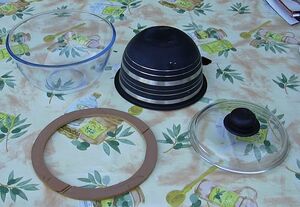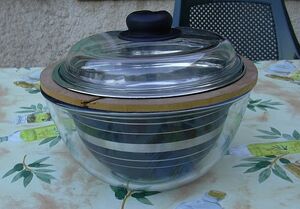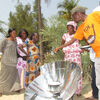- 5 Talk
-
Solar cooking pots
Redirected from Pots
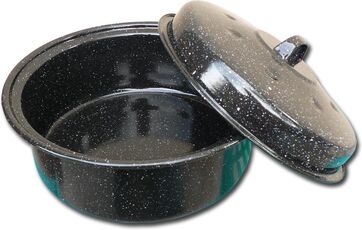
 Added by Tom Sponheim
Added by Tom SponheimContents |
Whenever we hear reports of people having trouble cooking in a solar cooker we most often find that they were using normal pots whose finish reflects the light away from the pot instead of absorbing it. Unless you're cooking with a parabolic solar cooker where the light is being focused in on the bottom of the pot, it is very important to use dark colored pots. Pots of thin material heat faster than thick ones. Metal heats faster than ceramic or earthenware. Cast iron is slow to heat initially but will work during good solar cooking conditions.
Occasionally it is fun to see the cooking. Lids may be left off of dark cakes, some cookies, corn chips with melting cheese, and a few other foods if desired. More moisture will condense on the glazing and the food will heat more slowly. Moisture condensing on the inside of the glazing may be wiped off intermittently with a clean soft cloth. In a box cooker if steaming persists and there is good sunlight, a small pebble or stick temporarily may be placed under the glazing frame or around the access door to open it slightly and allow moisture to vent. Lids can be either dark or clear.
Foil is not generally recommended to wrap food for solar cooking; however, temporary pots or lids may be formed out of one layer of darkened foil in absence of any other equipment. Conventionally foil-wrapped food cooks very slowly if at all because shiny foil, particularly in multiple layers, insulates by reflecting sunlight and heat away. Garlic bread wrapped in foil (and possibly other foods) will do much better in a solar oven if the foil wrapped loaf is covered by insertion in a thin black cotton-blend sock or black tube made from cotton tights.
Glass jars make good pots although they cook better if darkened rather than left clear. Also, darkening the outside of food containers will protect some of the B Vitamins. When painting the jars, a strip of masking tape placed from top to bottom before painting can be removed when the paint is dry to leave a tidy strip of clear glass for visual inspection of the inside.
Shiny pots or bread pans may be placed into brown paper bags or dark cloth bags to successfully cook without painting them. If using paper bags or cloths, heat them alone for several hours before using them with food in order to drive off any unwanted vapors. Alternatively, a number of separate foods may be cooked in small, clear jars all under one dark tray or dark lid of a roasting pan.
When using jars for cooking, make a hole in the lid of any non-canning jar, such as mayonnaise jars, peanut butter jars, etc., to prevent steam buildup. Dome and ring canning jar lids that are designed for food preservation automatically release excess steam pressure yet are safe only when used on canning strength, food preservation jars. The thickness and strength of non-canning glass jars is not intended to take the strain of steam under pressure and could break explosively unless vented.
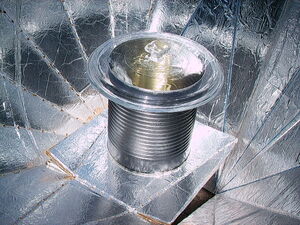
 Added by Frenchhorn
Added by FrenchhornSome low-fired earthenware pots do not initially cook well although dark colored, hard-fired earthenware pots with glazing work very well. Perhaps the poor performance of some earthenware is due to liquid soaking through and evaporating on the outside, or perhaps it is due to the thickness and porous nature of low-fired clay pot sides. Experimentally, in the efforts to use low-fired, unglazed earthenware, the goal has been to approximate the hard-fired pots by filling the pores and to providing a form of glazing. On a homecraft basis, this has been done by saturating the pot with food-type oil, fat or natural resin which both closes the pores and changes the surface. Oil also will conduct heat rather well and this may be part of what improves cooking in low-fired, earthenware pots following oil treatment. Light colored earthenware needs to be darkened on the outside only, perhaps by rubbing a dark food, nontoxic dark powder or soot from clean wood into the oil coating. Even so, there may be forms of low fired earthenware that are difficult to use for SBCs.
Gourds to be used as pots need to be fully ripened, scraped and cleaned to a thin hard shell and, if of a light-skin variety, need to be darkened on the outside. Gourds almost completely filled with food cooked better than gourds with a little food in the bottom. Experimentally, like with low-fired earthenware, treating inside and outside surfaces with vegetable oil or animal fat seems to improve the cooking times. Low temperature oils which scorch to a useful dark brown are olive oil, used lard, and peanut oil. The point at which oils will darken can be lowered by utilizing old oil that has been used for cooking, perhaps which still has food particle in it, or which has an added emulsifier.
The Santa Domingo gourds tested were kept sitting upright while they grew. After harvest, they were dried outdoors in the shade for some months until the seeds begin to rattle. Then the tops were cut off and the seeds and inner pulp removed. They were scraped to a hard surface inside and out. Our test gourds held between 1 and 1.5 quarts (.95 and 1.4 liters) and after preparing as pots were almost spherical with 3 inch (7.5 cm) openings. The sides were approximately 1/8 inch thick (.3 cm).They held liquids, did not flavor the food and produced cooked food over a period of many weeks. Heat seemed to penetrate slowly. Gourds cooked faster with lids made of a small squares of clear glass rather than dark lids, which sacrificed some level of B Vitamins in some foods. This was judged to be a minor effect compared to the convenience of being able to grow your own solar pots in some cases.
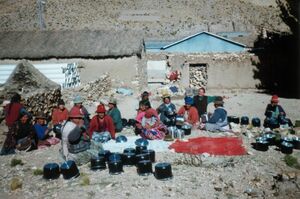
 Added by Ben Hedrick
Added by Ben HedrickOn an experimental basis, where very large gourds are available their shells might be evaluated for use as inner boxes. If they proved successful, used in conjunction with gourd pots in an insulated pit or other outer insulation, the materials needs for low temperature SBCs in equatorial regions might be reduced to simply foil for the inner surface of the large gourd and the glazing...or perhaps to only the glazing? This is highly speculative and cannot be appropriately evaluated at 34.4 N. Latitude where our work is done.
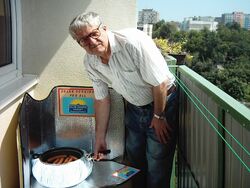
 Added by Ben Hedrick
Added by Ben HedrickPOT LIDS can be HOMEMADE by turning the pot upside down on a flattened piece of metal and drawing an outline. Cut the metal about ¼ inch (.6 cm) outside the line. File or sand the sharp edges to dull the cut surfaces and protect the fingers. This may be done simply by rubbing a rock along the cuts. Working regularly around the lid piece with pliers, bend the edge down at the line. Sometimes the fluting looks nice. If necessary, cut from the edge into the line to allow the pieces of edge to overlap. Darken the outside of the lid and heat it for several hours before using it with food. Temporary lids made be made by the same method using a brown paper bag and creasing the paper at the line. These also need to be heated alone for several hours before being used with food. Sometimes small holes are punched in a lid to allow moisture to escape and produce a drier crust on foods such as breads or breadcrumb toppings, cakes and cookies.
Nutritional research in great detail has been done by Professor George Hammons and others at Philander Smith College in Little Rock, Arkansas, USA. After analysis of many different nutrients in food cooked equal times by conventional methods and by solar box cookers using dark pots with lids they concluded that solar cooked foods retained nutrition as well as or better than foods cooked by conventional methods in spite of the longer cooking times required.
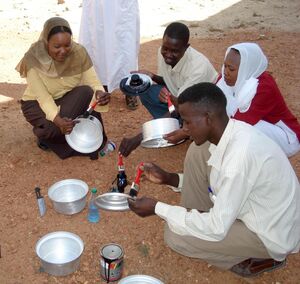
 Added by Tom Sponheim
Added by Tom SponheimSmall pieces of glass may serve as lids on many different pots, as mentioned previously. The question as to how much vitamin loss occurs when food is cooked without a pot lid or under clear glass needs to be researched. Judging from color changes, there may be some vitamin or nutrient change if food is exposed to bright sunlight while cooking. This may be more important when cooking liquids than when cooking solids, since liquids will circulate by convective flow exposing a greater proportion of the food to the sunlit edges. Riboflavin, a major B vitamin destroyed by light, is found in milk and milk products, eggs, liver, kidney, grass, fruits, leafy vegetables, yeast, etc. These foods with light-sensitive vitamins definitely should be cooked in dark containers.
Research is still needed comparing the effects of solar cooking with food exposed to the sunlight after it has passed through various layers of glazing with solar cooked food using lids. Research is also needed on whether or not there are significant amounts of aluminum compounds absorbed into the food from aluminum pots when foods, particularly acid foods, are cooked at the relatively low temperatures for extended periods of time typical of solar box cooking. Until the facts are established, foods should be cooked with dark covers and aluminum pots not be used unless no other pots are available. Also, there are unresolved questions at this time about the possible uptake of metal compounds into food cooked in tin cans.
[Text for this article was taken from The Expanding World of Solar Box Cooking by Barbara Kerr]
David Delaney recommends creating a "greenhouse pot" for solar panel cookers. Details can be found in the following articles:
- Pot with Integrated Greenhouse for Solar Panel Cooker - David Delaney
- Comparison of Lids for Greenhouse Pots for Solar Panel Cookers - David Delaney
- Improvising a Greenhouse Pot for Solar Panel Cooking - David Delaney
Tips and tricks Edit
Edit
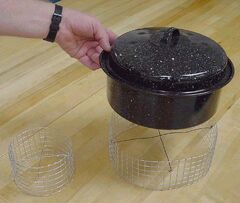 |
 |
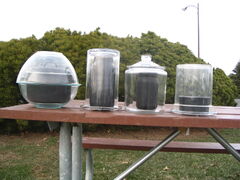 |
 |
Cooking with reflective or colored pots Edit
Edit

 Added by Paul Hedrick
Added by Paul Hedrick
 Added by Paul Hedrick
Added by Paul HedrickWhen cookware with a black surface is not available, it may still be possible to effectively use reflective or colored cookware with your solar cooker. Basically, it involves using a black cloth to cover the cookware after placing it in the cooker. Place the cloth as close to the pot surface as possible to minimize heat loss. Neelaratna Geekiyanage, from Sri Lanka, reports that he has used this technique to cook, pasteurize water, and make copra from scraped coconut to extract high quality coconut oil. He calls it the NG method.
Some alternative cooking pots Edit
Edit
- Smoked-glass casserole dishes. Pyrex makes a low-cost model available for $5 - $10 in stores in the US.
- Rough up glass jars with sandpaper and paint these black. Use masking tape to leave one clear strip for viewing.
- Cook in gourds with a small sheet of glass for a lid.
- Put shiny pots in a brown paper sack.
- Paint a shallow cake pan black and fashion a lid from a sheet of black-painted aluminum flashing with its edges folded down.
- Buy dark baking pans in matched pairs and use one upside-down as a lid for the other. Metal binder clips of the right size—medium to large range, depending on the pan rims—work well for holding them securely together.
Finned pots: Arezki Harmim writes in February 2009: "Within the framework of a project of development and popularization of solar cooking in Algerian Sahara, registered in the program of the Unit of research in renewable energies in Saharan medium installed in Adrar (located at the south of Algeria), our team of research proposed the use of a finned cooking vessel with an aim of improving the solar cookers performances. Fins attached to the external surface of the cooking vessel increase the heat transfer surface area. This improves the heat transfer from the internal hot air of the cooker towards the interior of the vessel where the food to be cooked is placed. Indeed the various experimental tests carried out with the help of a double exposure solar cooker and a finned cooking vessel showed that there is a clear reduction of the cooking time in comparison with the same cooker tested under the same conditions but with an ordinary cooking vessel. The same results were also recorded with a simple box type solar cooker. An example of the finned cooking vessel is shown in the figure."
Build your own HotPot bowl Edit
Edit
A few creative solar enthusiasts have been working on ideas to make a HotPot bowl that is inexpensive and easy to use. They incorporate a black pot inside of a larger Pyrex style bowl and lid with an insulated handle. As seen in photos, the addition of a wooden spacer ring has helped provide a seal between pots of slightly different sizes.
Candidates for components include:
- Pyrex® Sculptured 4-3/4-qt Bowl
- Pyrex® 2-qt Casserole w/ Cover <--(only large one sold w/cover)
- Pyrex® 4-qt Mixing Bowl
- Granite Ware 4 quart beanpot
- Granite Ware 4 Quart Stockpot with Steamer Insert
- Granite Ware 4 Quart Covered Sauce Pot
- Global Sun Oven, Granite Ware, Enamel, 3-quart Pot
Research needed Edit
Edit
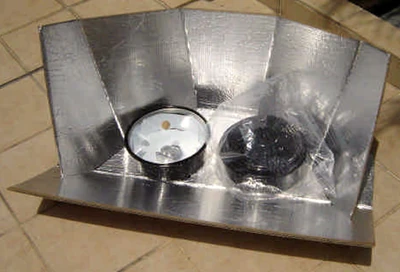
Teong Tan found that a black pot with a clear lid without a plastic bag (left) heated faster than a normal dark pot with a dark lid inside a plastic bag (right). See Greenhouse enclosure comparisons  Added by Tom Sponheim
Added by Tom Sponheim
- SCI has been sent a calculation by a scientist in Argentina who has calculated that evacuating the space between the two bowls supplied with the HotPot solar cooker would result in 60% better cooking performance. See: Create your own evacuated vacuum tube
- Other topics needing research

 Added by
Added by 
